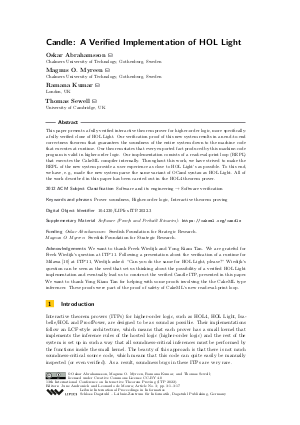@InProceedings{abrahamsson_et_al:LIPIcs.ITP.2022.3,
author = {Abrahamsson, Oskar and Myreen, Magnus O. and Kumar, Ramana and Sewell, Thomas},
title = {{Candle: A Verified Implementation of HOL Light}},
booktitle = {13th International Conference on Interactive Theorem Proving (ITP 2022)},
pages = {3:1--3:17},
series = {Leibniz International Proceedings in Informatics (LIPIcs)},
ISBN = {978-3-95977-252-5},
ISSN = {1868-8969},
year = {2022},
volume = {237},
editor = {Andronick, June and de Moura, Leonardo},
publisher = {Schloss Dagstuhl -- Leibniz-Zentrum f{\"u}r Informatik},
address = {Dagstuhl, Germany},
URL = {https://drops-dev.dagstuhl.de/entities/document/10.4230/LIPIcs.ITP.2022.3},
URN = {urn:nbn:de:0030-drops-167126},
doi = {10.4230/LIPIcs.ITP.2022.3},
annote = {Keywords: Prover soundness, Higher-order logic, Interactive theorem proving}
}

 Creative Commons Attribution 4.0 International license
Creative Commons Attribution 4.0 International license

